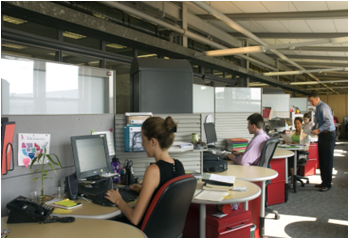Sustainability Topics
Energy Management Systems (EnMS)
Energy Management Systems (EnMS) are a set of business processes that enable facility managers to act on energy usage data and optimize efficiency while identifying areas for improvement.
Continue reading: Energy Management Systems (EnMS)Materials & Resources
In the construction and day-to-day operations of buildings, many materials and resources are used and a great deal of waste is generated. The materials selected for use in a facility and the way they are disposed of impact the environment.
Continue reading: Materials & ResourcesBuilding Selection
Welcome Back
Sustainable Sites
Circadian Light
What is Sustainability?
Indoor Environmental Quality (IEQ)
Indoor Environmental Quality (IEQ) is most simply described as the conditions inside the building. It includes air quality, but also access to daylight and views, pleasant acoustic conditions, and occupant control over lighting and thermal comfort.
Continue reading: Indoor Environmental Quality (IEQ)Sustainability Program Development
Sustainability Programs incorporate all building stakeholders into the design process, promoting awareness, goal development, implementation, acceptance, and effectiveness of facility sustainability efforts.
Continue reading: Sustainability Program DevelopmentBuilding Water Use
Buildings are significant users of the Earth’s freshwater supply. The goal of a responsible building operator should be to encourage a smarter use of water, both inside and outside the facility.
Continue reading: Building Water UseHealthy Cleaning
Child Care Centers
Because children spend such long hours at child care centers, the design of their spaces is especially critical. The design effort must allow for, and be sensitive to, the differences in space attributes for children and those for adults as well as the differences in space usage by the children in different age groups.
Continue reading: Child Care CentersHealth Enhancing Strategies
Environmental Programs
Environmental purchasing programs help federal buyers identify products and services that have a smaller or reduced negative effect on the environmental and human health. Federal agencies are required to buy sustainable products and services to the maximum extent practicable.
Continue reading: Environmental ProgramsGreenhouse Gas Accounting
Plug Load Nuggets
Plug Loads
Plug loads refer to energy used by equipment that is plugged into an outlet. In an office, key plug loads include computer and monitors, printers, and copiers. Plug loads can average approximately 30% of electricity use in office settings, much of which can be attributed to parasitic loads (or the power draw of a plug-load that is not performing useful work).
Plug loads as a share of overall building energy use is higher in energy efficient buildings. In minimally code-compliant office buildings, plug loads may account for up to 25% of total energy consumption. But in high efficiency buildings, plug loads may account for more than 50% of the total energy consumption.
You can reduce plug loads by up to 50% at your facility by utilizing an integrated team approach and implementing simple, no cost and low cost plug load control strategies.Explore the Plug Load section to discover the importance of advanced power strips (APS), occupant education and power management in combating these energy-wasters.
Continue reading: Plug LoadsPlug Load Frequently Ask Questions (FAQ)
Climate Terms and Tools
Embodied Carbon
Biophilia and Design
Building Energy Storage
Grid-Interactive Efficient Buildings
Building Energy Use
Building Decarbonization
Green Building Certification Systems
Building Energy Security and Efficiency
Guiding Principles for Sustainable Federal Buildings
The Federal Government advances sustainable building principles and practices throughout its portfolio, promulgated through a number of statutory and executive policies which are integrated and utilized by every Federal agency. These sustainable principles and practices have been incorporated into the Guiding Principles for Sustainable Federal Buildings and Associated Instructions (Guiding Principles), to guide agencies in designing, locating, constructing, maintaining, and operating Federal buildings in a sustainable manner that increases efficiency, optimizes performance, eliminates unnecessary use of resources, ensures the health of occupants, protects the environment, generates cost savings, and mitigates risks to assets in a manner consistent with Agency and Department missions. View the Guiding Principles![]() . For additional guidance on meeting the Guiding Principles, see SFTool/guidingprinciples, search SFTool or see the Whole Building Design Guide (WBDG)
. For additional guidance on meeting the Guiding Principles, see SFTool/guidingprinciples, search SFTool or see the Whole Building Design Guide (WBDG)![]() .
.
Buildings and Health
The challenge for building design and operations is to identify and eliminate health risks while also providing positive physical, emotional, and social supports as well as coping resources.
Continue reading: Buildings and Health
